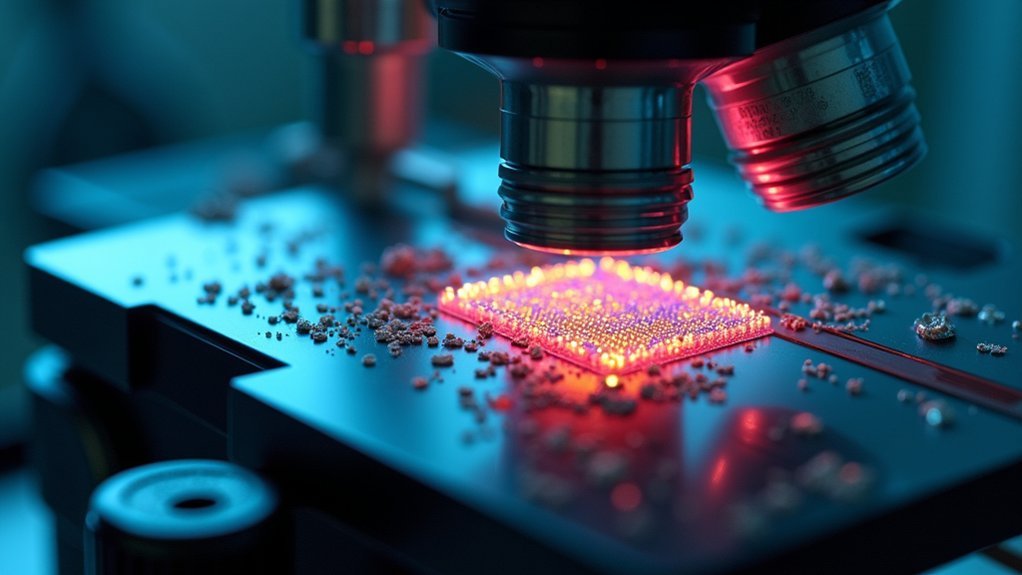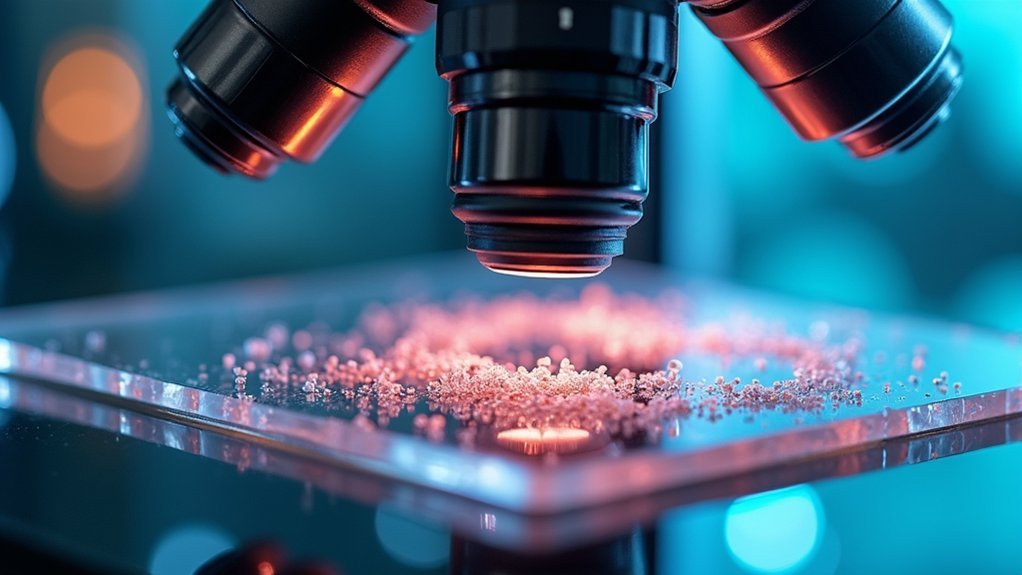Microscope binning combines adjacent pixels to boost speed and sensitivity at the expense of resolution. You’ll achieve up to four times faster frame rates with 2×2 binning while considerably improving signal-to-noise ratio in low-light conditions. CCD cameras offer superior binning benefits (up to 4:1 SNR improvement) through on-chip processing compared to CMOS sensors’ post-digitization binning (up to 2:1). The best binning pattern depends on your specimen type and illumination conditions. Discover which configuration will maximize your imaging success.
Microscope Binning: High Resolution Vs Speed Trade-Offs

When you’re pushing the limits of microscopy, you’ll often face the fundamental trade-off between image quality and acquisition speed. Binning offers a solution by combining adjacent pixels in configurations like 2×2 or 4×4, dramatically increasing frame rates up to four times faster than standard imaging.
While binning boosts your signal-to-noise ratio—especially valuable in dim imaging scenarios—it comes at the cost of reduced spatial resolution. Your effective pixel count decreases as binning increases.
In low-light microscopy, binning enhances signal quality at the inevitable expense of resolution detail—a classic scientific compromise.
CCD sensors leverage on-chip binning for superior SNR improvements compared to CMOS sensors, which bin after digitization with less impressive results.
Your choice of binning configuration should align with specific research needs. Larger bins deliver smoother data and faster acquisition but sacrifice the fine details that might be critical for your analysis.
Pixel Binning Fundamentals in Microscopy
Pixel binning combines adjacent pixels into larger superpixels through a digital process that reduces resolution but enhances signal detection.
You’ll notice an immediate improvement in camera sensitivity as binning increases the signal-to-noise ratio, with CCD cameras achieving up to 4:1 SNR improvements through on-chip binning.
While you’re gaining better light sensitivity and faster acquisition speeds, you’re sacrificing spatial detail—a fundamental trade-off that requires careful consideration based on your specific imaging requirements.
Digital Combination Process
The digital combination process known as pixel binning represents one of the most powerful techniques available in modern microscope imaging systems. When you’re using this method, you’re fundamentally grouping adjacent pixels into larger superpixels, creating significant improvements in signal-to-noise ratio and frame rates.
CCD cameras offer superior SNR enhancement (up to 4:1) through on-chip binning before readout, while CMOS cameras provide more modest improvements (up to 2:1) with post-digitization binning.
You’ll notice frame rates can increase dramatically—a 2×2 configuration can quadruple your imaging speed.
However, you’re making a clear trade-off: as you gain sensitivity and speed, you’ll sacrifice spatial resolution. To maximize your imaging results, you’ll need to strategically balance these factors based on your specific experimental requirements.
Resolution Reduction Effects
Although you’ll gain considerable improvements in signal-to-noise ratio and acquisition speed, understanding the resolution reduction effects of pixel binning is essential for ideal microscopy results.
When you implement binning, your effective pixel size increases proportionally to your binning strategy.
- A 2×2 binning configuration nearly doubles your signal-to-noise ratio (7:1 to 13:1) but halves spatial resolution
- Larger binning configurations create smoother images but greatly sacrifice detail clarity
- CCD sensors handle on-chip binning better than CMOS sensors, which experience post-digitization noise
- Your binning strategy should carefully balance resolution loss against speed requirements
Remember that while binning accelerates frame rates, the corresponding reduction in spatial resolution means fine structural details may become indistinguishable—a critical consideration when imaging complex biological specimens.
Camera Sensitivity Improvement
When operating in low-light conditions, pixel binning emerges as a powerful technique to enhance your microscope’s sensitivity and improve image quality. By combining adjacent pixels, you’ll greatly boost your signal-to-noise ratio—for example, 2×2 binning can increase SNR from 7:1 to 13:1, making previously invisible structures detectable.
CCD cameras offer superior sensitivity gains through on-chip binning, achieving up to 4:1 SNR improvements compared to the modest 2:1 enhancement from CMOS cameras’ off-chip binning.
While you’ll trade some spatial resolution when implementing binning, you’ll gain remarkably faster acquisition speed—up to four times faster with 2×2 binning configurations. This makes it ideal for capturing rapid biological processes where sensitivity matters more than maximum resolution.
You’re effectively balancing detail against the ability to detect faint signals in challenging imaging scenarios.
CCD Vs CMOS Binning: Technical Distinctions
Fundamental differences in binning technology create a clear performance divide between CCD and CMOS sensors in microscopy applications.
When working at low light levels, you’ll notice CCD cameras perform pixel binning on-chip before readout, boosting signal-to-noise ratio by up to 4:1. CMOS sensors, however, bin after digitization, achieving only a 2:1 improvement.
- CCDs combine charges before readout, effectively reducing read noise during image acquisition.
- CMOS systems process already-digitized signals, preserving noise characteristics.
- On-chip CCD binning enables superior performance in challenging lighting conditions.
- CMOS cameras trade binning quality for faster frame rates in high-speed applications.
For microscopy requiring maximum sensitivity, CCDs remain the superior choice, while CMOS excels when rapid image acquisition takes priority over ultimate noise performance.
On-Chip Vs Off-Chip Binning Processes

The distinction between on-chip and off-chip binning processes represents a critical factor in microscopy sensor performance. When you’re selecting imaging technology for low-light applications, understanding these differences becomes essential.
| Feature | On-Chip Binning (CCD/EMCCD) | Off-Chip Binning (CMOS) |
|---|---|---|
| Processing Stage | Before readout | After digitization |
| SNR Improvement | Up to 4:1 | Limited to 2:1 |
| Noise Impact | Reduces read noise | Adds processing noise |
| Frame Rate | Significant increase | Minimal improvement |
| Application Suitability | Ideal for low-light imaging | Better for bright-field |
With on-chip binning, CCD sensors combine pixel charges before readout, maximizing signal-to-noise ratio while minimizing noise. In contrast, CMOS sensors perform off-chip binning after digitization, yielding modest SNR improvements. The charge transfer optimization in CCD systems enables faster frame rates and enhanced sensitivity, making them superior for demanding microscopy applications.
Signal-to-Noise Ratio Enhancement Through Binning
Perhaps the most compelling reason to implement binning in microscopy is its remarkable ability to enhance signal-to-noise ratio (SNR).
When you’re working with low-light imaging, binning can transform a barely visible 7:1 SNR into a much clearer 13:1 ratio by combining adjacent pixel signals.
CCD cameras offer superior SNR improvements through on-chip binning, which tackles read noise before digital conversion.
This provides up to 4× improvement compared to the modest 2× gain in CMOS sensors using post-digitization binning.
- Faint specimens suddenly become visible with 2×2 binning
- On-chip binning preserves signal integrity while reducing background noise
- Detail-critical applications benefit from smaller bin sizes
- Low-light fluorescence imaging becomes feasible without increasing exposure time
Frame Rate Acceleration in Scientific Imaging

When you’re pursuing high-speed scientific imaging, binning configurations like 2×2 can boost your frame rates up to four times by processing multiple pixels simultaneously.
You’ll find CCD cameras leverage on-chip binning for superior signal quality in low-light applications, while CMOS sensors offer faster frame rates but with less effective noise reduction through post-digitization binning.
Your frame buffering strategies and sensor readout optimization become critical as you balance between achieving hundreds of frames per second and maintaining sufficient spatial resolution for your specific imaging requirements.
Subheading Discussion Points
Because scientific experiments often require capturing fleeting biological processes or rapid physical phenomena, frame rate optimization becomes a critical consideration when configuring microscopy systems.
When you’re deciding between resolution and speed, binning offers a compelling solution to boost your frame rate while managing image quality and read noise.
- On-sensor binning can greatly increase acquisition speeds up to four times faster with 2×2 configurations, while maintaining acceptable signal to noise ratios.
- Your sensor type determines binning efficiency – hardware-based approaches markedly outperform digital binning for speed enhancements.
- Multiple pixels processed simultaneously during single readout events can achieve hundreds of frames per second.
- Low-light imaging benefits most from on-sensor binning, whereas digital binning introduces additional noise without frame rate improvements.
Frame Buffering Techniques
While binning directly manipulates pixel data, frame buffering represents another critical strategy in your microscopy speed optimization toolkit. This technique temporarily stores image data in memory, allowing for rapid access and processing during acquisitions.
You’ll achieve up to four times faster effective frame rates by implementing on-chip binning alongside frame buffering, as it reduces the number of pixels processed per readout.
When capturing dynamic events, advanced buffering strategies enable your camera to handle multiple frames simultaneously without sacrificing temporal resolution.
Frame buffering minimizes latency while maximizing throughput in high-speed imaging applications, facilitating hundreds to thousands of frames per second—particularly valuable for live-cell imaging.
You can also seamlessly shift between resolution modes based on your specific imaging needs without compromising overall image quality.
Sensor Readout Optimization
Beyond frame buffering, the core speed limitations of your microscopy system often reside at the sensor level itself.
When you’re capturing rapid sequences, on-sensor binning emerges as the best technique for frame rate acceleration. By combining pixels before digitization, you’ll greatly reduce read noise while enhancing signal-to-noise ratio in your digital imaging systems.
- 2×2 binning configurations can quadruple your frame rates without sacrificing essential image quality
- On-sensor binning bypasses the digitization bottleneck that typically constrains readout speeds
- Frame rates can reach hundreds of frames per second with ideal binning strategies
- Unlike digital binning (post-digitization), on-sensor approaches prevent noise floor elevation
Implementing sensor readout optimization through binning provides the perfect balance between acquisition speed and image fidelity—particularly vital when every millisecond counts in dynamic microscopy applications.
Resolution Compromise: Understanding the Trade-offs

Although microscope binning offers significant advantages in signal-to-noise ratio improvements, these benefits come with measurable costs to image resolution.
When you implement binning techniques like 2×2 pixel grouping, you’ll boost your SNR from 7:1 to 13:1, but you’re sacrificing the ability to capture fine details in your specimens.
This trade-off becomes more pronounced with larger bin sizes. While 4×4 or 8×8 binning creates smoother images in low-light conditions, spatial resolution decreases dramatically.
CCD cameras typically handle this compromise better than CMOS sensors, which may introduce additional noise during post-digitization binning.
You’ll need to carefully balance your priorities: higher frame rates and improved sensitivity in challenging lighting versus the resolution needed for detailed analysis.
Your experimental requirements should ultimately determine the appropriate binning strategy.
Optimizing Binning Patterns for Different Specimens
When choosing binning patterns for your specimens, you’ll need to tailor your approach based on the sample’s light emission characteristics and structural complexity.
For fluorescently labeled cell components requiring precise localization, you’re better off using minimal binning (1×1) or low binning (2×2) to preserve critical spatial information and prevent resolution loss at boundaries.
Conversely, if you’re imaging thick tissue sections or tracking rapid cellular dynamics in low-light conditions, larger binning patterns (4×4) will dramatically improve your signal-to-noise ratio and frame rates at an acceptable resolution cost.
Specimen-Specific Binning Strategies
Since each microscopy specimen presents unique imaging challenges, tailoring your binning strategy to specific specimen characteristics can dramatically improve outcomes.
When developing your specimen-specific binning approach, consider how the optical properties of your sample interact with your microscope’s capabilities.
- For light-sensitive specimens with faint signals, use smaller bins (2×2) to enhance signal-to-noise ratio while preserving detail.
- With rapidly moving organisms, employ larger bins (4×4 or 8×8) to capture faster frame rates without motion blur.
- Match your binning pattern to the specimen’s size and structural features to optimize resolution where it matters most.
- Consider fluorescence intensity when deciding between on-chip or software-based binning; the former works better for low-intensity samples requiring real-time processing.
Resolution-Critical Cell Structures
Imaging cellular structures at high resolution demands careful optimization of your binning strategy, especially for resolution-dependent organelles like mitochondria, nuclear pores, and synaptic junctions.
For these fine features, lower binning configurations (2×2) deliver the best balance between enhanced signal-to-noise ratio and preserved spatial resolution. You’ll improve SNR from 7:1 to 13:1 without sacrificing critical image clarity during low-light imaging.
While larger binning sizes (4×4) boost sensitivity and frame rates, they compromise the detail needed for analyzing organelles and membranes.
Consider your specimen’s characteristics when selecting binning patterns. Larger pixels or on-chip binning outperform post-digitization methods in CMOS sensors under low-light conditions.
Additionally, prioritize sensors with higher dynamic range and well depth to capture more signal from delicate samples without saturation.
Hardware Vs Software Binning Approaches

Although both approaches aim to enhance microscope imaging performance, hardware and software binning differ fundamentally in their implementation and results.
When choosing between them for your imaging needs, understanding their distinct advantages is essential.
- Hardware binning in CCD cameras combines pixel charges pre-readout, dramatically boosting signal-to-noise ratio up to 4:1 while maintaining lower noise profiles.
- Software binning processes pixels after digitization in CMOS setups, resulting in more modest 2:1 SNR improvements and potentially higher read noise.
- Your low-light imaging applications will benefit considerably more from hardware binning’s superior sensitivity and noise characteristics.
- When capturing dynamic specimens, hardware binning increases frame rates by processing multiple pixels simultaneously, while software binning offers no comparable speed advantage.
Dynamic Range Considerations in Binned Images
Dynamic range represents one of the most important yet often overlooked aspects of binned microscopy imaging. When you implement binning, you’re fundamentally making a calculated trade-off: combining pixel signals can reduce read noise and enhance signal-to-noise ratios in low-light conditions, potentially improving dynamic range.
However, be cautious with larger bin sizes. While they boost sensitivity, they may actually decrease dynamic range through saturation effects that limit fine detail visibility. CCD sensors with on-chip binning maintain lower noise floors compared to CMOS digital binning, preserving dynamic range more effectively.
Your illumination conditions matter considerably—high light levels can quickly saturate binned sensors. For optimal imaging, you’ll need to balance sensitivity and dynamic range requirements against inevitable losses in spatial resolution, adjusting your binning strategy based on your specific imaging needs.
Binning Effects on Fluorescence Microscopy
When working with fluorescence microscopy, binning becomes a particularly powerful technique for visualizing faint biological signals that might otherwise remain invisible. Your CCD camera’s on-sensor binning can dramatically improve signal-to-noise ratio—boosting SNR from 7:1 to 13:1 with just 2×2 binning—far outperforming digital binning in CMOS systems.
- Watch as previously invisible organelles suddenly appear from the background noise
- Capture rapid cellular processes with frame rates up to four times faster
- Transform dim fluorescent proteins into bright, analyzable signals
- See dynamic interactions unfold in real-time without losing your sample to photobleaching
Remember that you’re trading spatial resolution for sensitivity and speed—a worthwhile compromise when tracking dynamic events or working with light-sensitive specimens.
Sacrifice pixels, gain insights—binning transforms microscopy’s most elusive signals into scientific breakthroughs.
Always monitor illumination levels to prevent sensor saturation when using this signal-amplifying technique.
Frequently Asked Questions
Does Binning Increase Frame Rate?
Yes, binning increases frame rates. You’ll achieve up to four times faster frame rates with 2×2 binning. On-sensor binning is particularly effective, as it reduces pixel processing during readout, unlike digital binning.
What Is a High Resolution Microscope?
A high-resolution microscope lets you visualize extremely small structures with exceptional clarity, typically achieving spatial resolutions of 200 nanometers or better. You’ll see cellular details that aren’t visible with standard microscopes.
In Summary
When you’re selecting binning settings for your microscope, you’re always balancing resolution against speed. You’ll need to take into account your specific specimen type, lighting conditions, and research objectives. Remember that while binning boosts your acquisition rate and improves signal-to-noise ratio, you’ll sacrifice spatial resolution. Choose hardware binning for better noise performance or software binning for flexibility. The ideal configuration isn’t universal—it’s the one that meets your experimental needs.





Leave a Reply